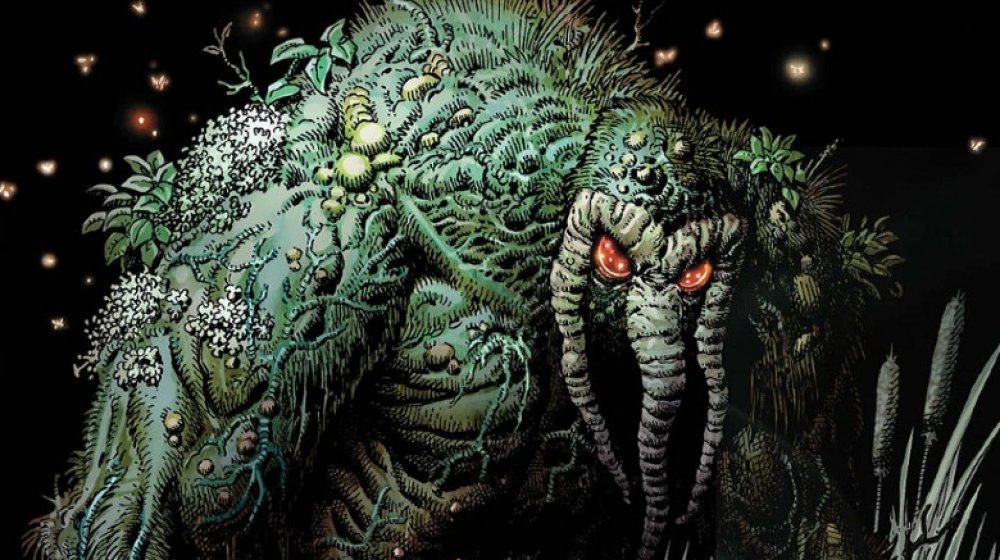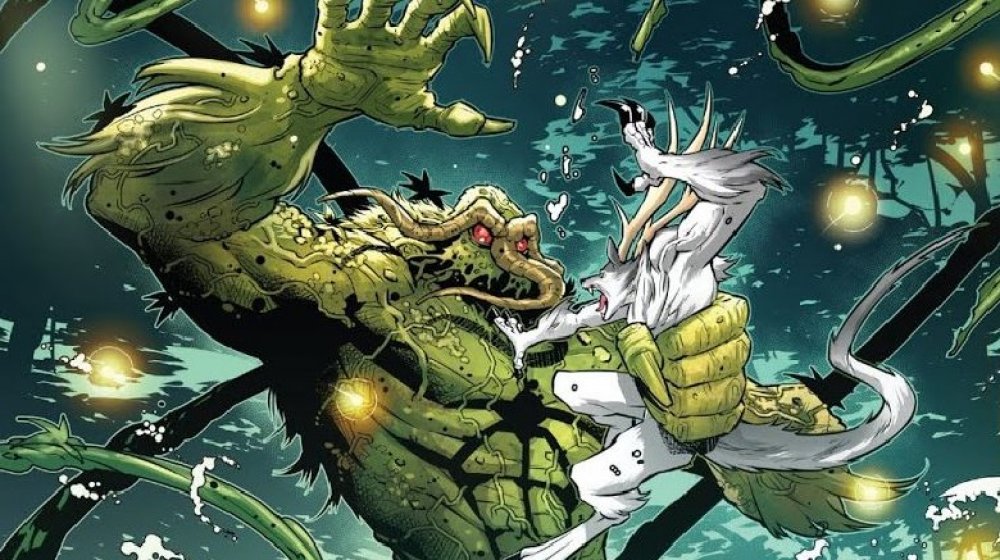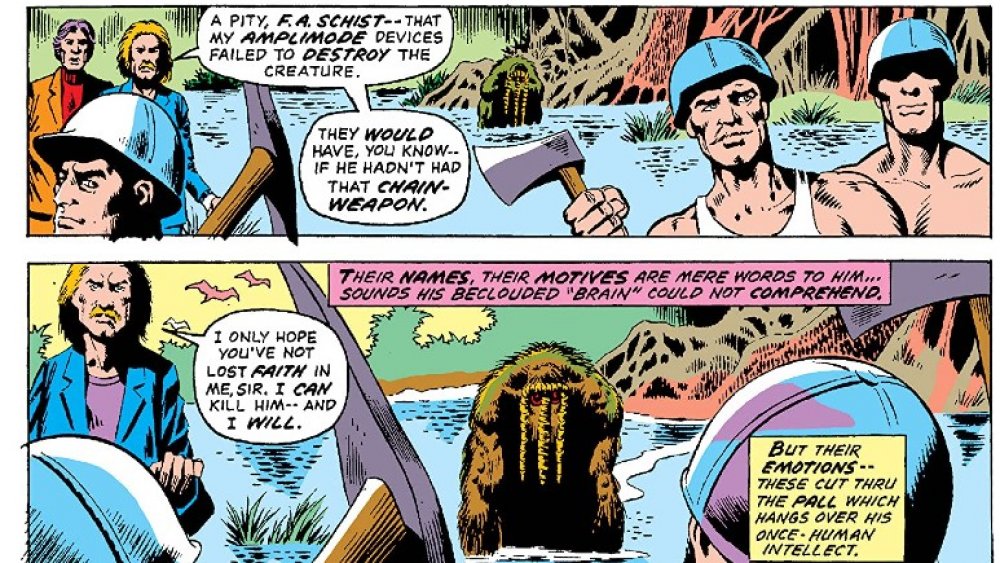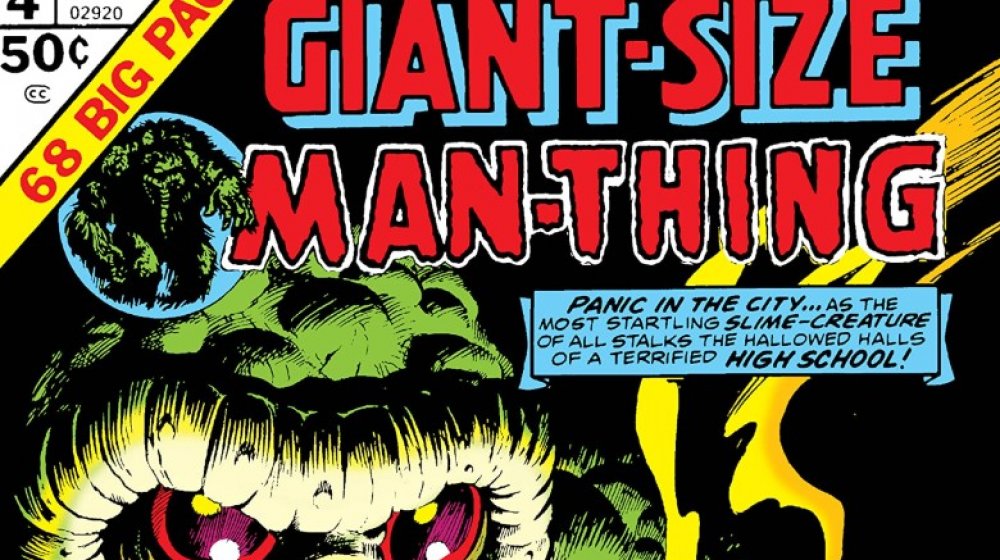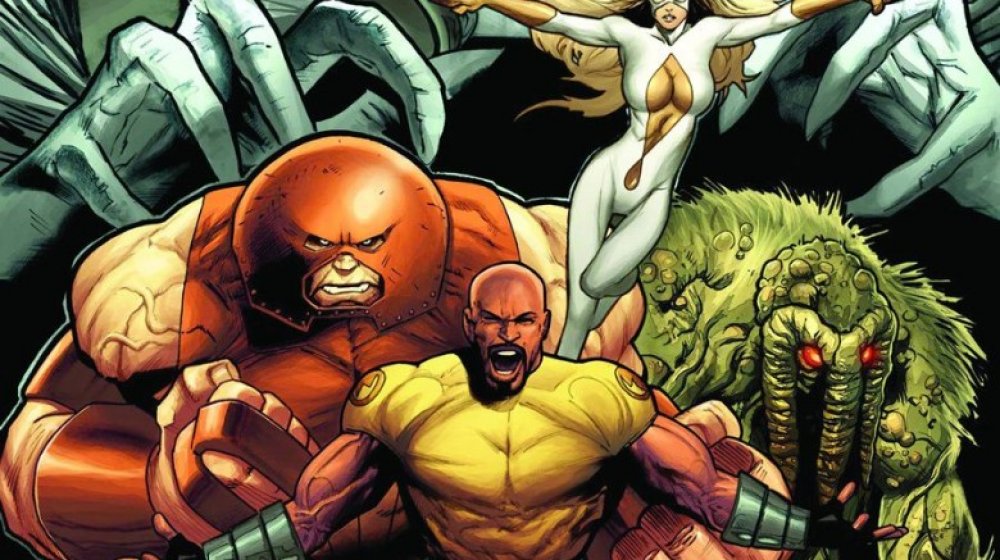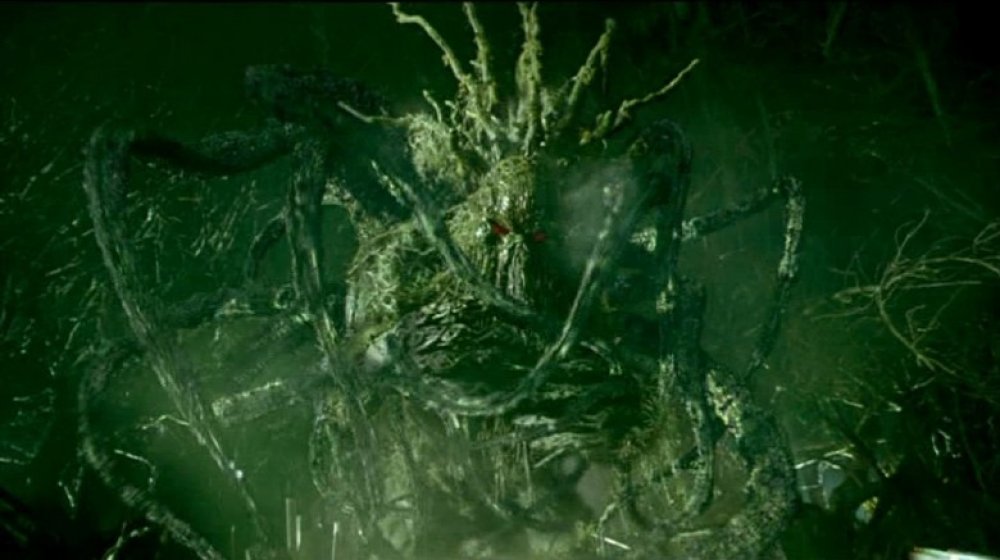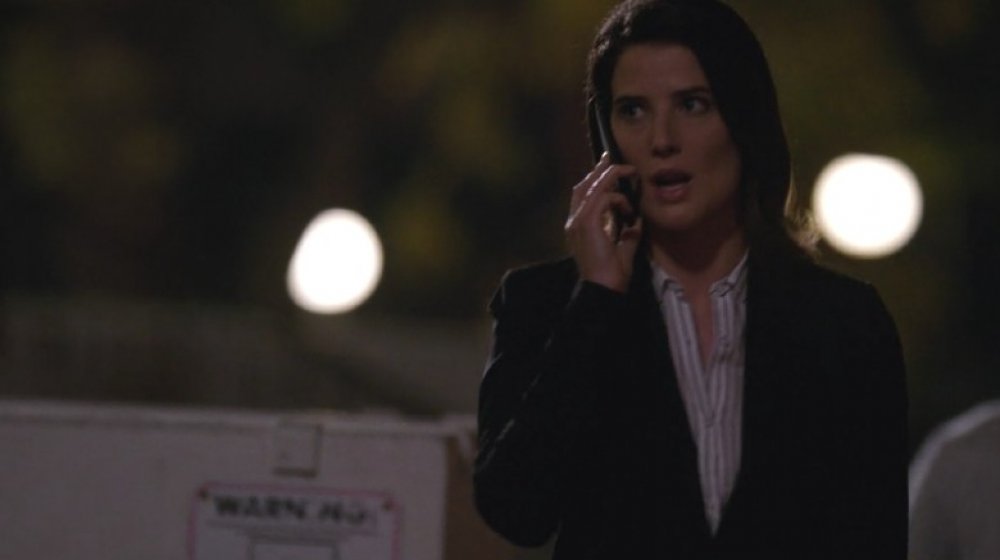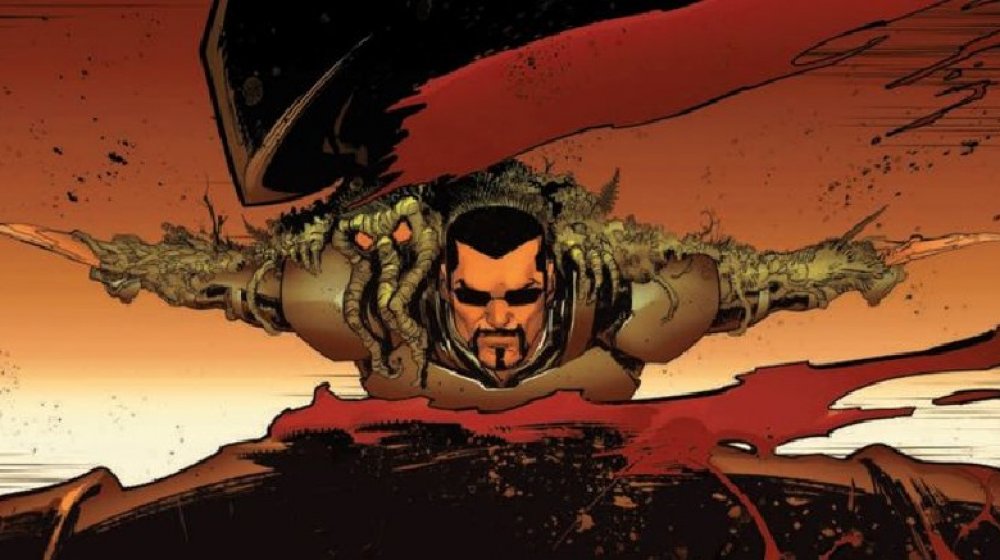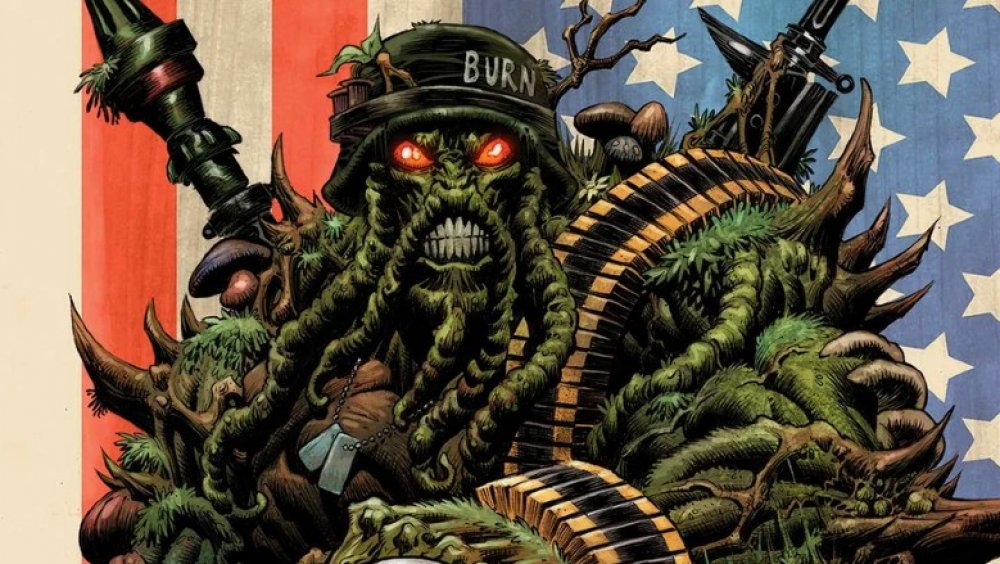The Untold Truth Of Man-Thing
"Whatever knows fear burns at the Man-Thing's touch!" So goes the closest thing Man-Thing has to a slogan. While Man-Thing himself can't utter it, the dire warning has become his slogan. Within his stories, it is usually deployed just before some unfortunate villain is set alight by contact with the veggie-based beast, and was printed at the top of most issues of the monster's 1979 comic series.
Once upon a time, Dr. Ted Sallis was working in Florida's Everglades to reproduce the super-soldier serum that gave Steve Rogers his abilities. Unfortunately, his wife betrayed him to the villainous A.I.M. organization. Sallis, desperate, injected the serum into his own body, then crashed his car into a swamp. Unbeknownst to Sallis, the swamp he crashed into is a mystic focal point of the Marvel universe. The magical energies of the swamp and the super-soldier formula within Sallis combined to create Man-Thing, the monster Marvel dubbed "the most startling swamp creature of all!"
While Man-Thing is one of Marvel's more obscure characters, he has a larger presence on the big and small screens than you might realize. Read on for the untold truth of Man-Thing, Marvel's strangest (and swampiest) inter-dimensional guardian.
Whatever knows fear...
After his fateful accident, Ted Sallis became the voiceless guardian of the Nexus of All Realities which, it turns out, is located in the Florida Everglades. Luckily, the Nexus provides him with the tools to be a capable guardian. Most impressively, Man-Thing's relationship to the Nexus grants him the power to travel between dimensions and even bring others with him. In addition to this, during brief periods when he regains the ability to speak, Man-Thing's speech can be understood by any intelligent creature in any dimension.
Man-Thing's other abilities are about what you'd expect from a Marvel superhero, but that doesn't make them any less impressive. Notably, his unique physiology makes him a challenging opponent for even Marvel's strongest. For example, while it would be difficult for Man-Thing to do much damage to a powerhouse like the Hulk, it's even more difficult for Hulk to hurt Man-Thing, as his regeneration abilities keep the swamp creature from ever being down for long. The Hulk has ripped off Man-Thing's limbs and even punched right through his body, only for the creature to reform moments later.
And then there are the empathic abilities for which he is best known. While Man-Thing no longer has a brain, he can sense strong emotions and react powerfully to them. For someone feeling strong fear, Man-Thing's barest touch is lethal. Seriously: He secretes acid which sets any fearful person in physical contact with him on fire.
A vessel for social commentary
Man-Thing's story isn't just thrilling — it's often politically conscious. As Sean Howe writes in Marvel Comics: The Untold Story, Steve Gerber's subversive Man-Thing series "tackled sexual politics, nudged their protagonists into counter-cultural pursuits, and even offered sly commentary on Marvel Comics itself."
While Gerber wasn't one of Man-Thing's creators, he became the writer best known for memorable Man-Thing stories. He wrote most the creature's appearances in Fear, all of his first solo series, and the title features for all 5 issues of Giant-Size Man-Thing. He would return to the swamp monster years later for a story in the anthology series Marvel Comics Presents, and after his death, Marvel published Gerber's final Man-Thing story as Infernal Man-Thing, a three-issue miniseries.
Gerber is not a writer interested in subtlety. A perfect example is the powerful businessman Franklin Armstrong Schist — i.e. F.A. Schist, which looks and sounds a lot like "fascist" — who acts as villain in early issues of Man-Thing. The beginning of the series is filled with criminals tasked by Schist with destroying Man-Thing, whose very presence is foiling his plans to level parts of the swamp so he can build an airport. Gerber had a point of view to share, and it makes his body of work all the more impressive.
He helped introduce Howard the Duck
While there are plenty of reasons not to bother with 1986's Howard the Duck, the talking bird's comic series was one of the high points of 1970s Marvel. And funnily enough, Marvel's master of Quack-Fu owes his origins to Man-Thing.
In a 1979 interview reprinted in the 2019 book Steve Gerber: Conversations, Gerber explains that he and artist Val Mayerik snuck Howard the Duck's creation into 1973's Fear #19. Gerber wanted something "wild, something off-the-wall," so when the sword-wielding warrior Korrek tries and fails to kill Man-Thing, Howard the Duck abruptly wanders into the action. Gerber's editor, Roy Thomas, wasn't crazy about the duck, but the publishing schedule was such that there was no time to take him out of the comic. Instead, Thomas ordered the duck's execution. In Man-Thing #1, Howard falls to his apparent death.
In spite of Howard only appearing in two issues before his demise, the fans refused to accept his death. Gerber said the Marvel offices received "tons of angry mail" from fans wanting the duck back, and even Stan Lee was getting flak from fans on his college lecture tours. In one disturbingly extreme example, a Canadian fan wrote an angry letter which was attached to an actual dead duck when it arrived at Marvel's offices. Soon, Howard was back in the land of the living and by 1976, he had his own solo series.
Giant-Size Man-Thing
One of the more enduring aspects of Man-Thing's legacy is the unintentional double entendre provided by one of his comic's titles: Giant-Size Man-Thing.
In the 1970s, most of Marvel's best-sellers eventually got the "Giant-Size" treatment: Comics four times as long as most monthly comics, usually including reprints of older stories as back-up features. The mid-70s brought with it issues of Giant-Size Avengers, Giant-Size X-Men, Giant-Size Spider-Man, and more. But unlike those other titles, the release of Giant-Size Man-Thing led to a lot of snickering and in-jokes which live on in the conversations of today's comics fans.
Not above making fun of themselves, Marvel's gotten in on the joke themselves. In 2011's Thunderbolts #162, the swamp monster helps his team save Chicago from swarms of monsters. Man-Thing is able to physically absorb the monsters, growing larger with each defeated fiend. Eventually he becomes, as his teammate Songbird exclaims, a "giant-size Man-Thing."
It's an old joke, but one that's not likely to lose its appeal any time soon.
Man-Thing was a Thunderbolt
As powerful as he is, Man-Thing isn't much of a team player. For one thing, he is usually incapable of speech. Nor does he care much about fighting crime or saving the world. He will defend himself if attacked, but otherwise, his reactions to others are limited by his instinctive response to their emotions.
Regardless, Man-Thing was once part of a team known as the Thunderbolts. This group first popped up in the 1990s as supervillains disguised as superheroes, most of whom decide to change sides and turn on their villainous leader, Baron Zemo. A number of different incarnations of the team have sprung up over the years, with Luke Cage taking charge of the team following the 2010 Siege event. In Thunderbolts #144, Hank Pym surprises Cage with the reveal that Man-Thing will be one of his team's recruits. While he's valuable in battle, the Thunderbolts want the swamp monster mainly for his ability to travel through dimensions, which enables the team to go anywhere in the world instantly.
While he's not a supervillain like teammates Juggernaut or Crossbones, Man-Thing doesn't like being a captive soldier very much. He escapes the team's clutches a number of times, eventually being recaptured and inducted into the monster-themed Howling Commandos of S.H.I.E.L.D.
He's already appeared in a movie
Three years before the Marvel Cinematic Universe was born with Iron Man, Marvel's startling swamp-creature appeared on the big screen. Still, we don't think Iron Man, the other Avengers, or any of the MCU's heroes are very jealous of the monster — his movie isn't exactly beloved.
A horror film set in Louisiana, 2005's Man-Thing was initially meant for a direct-to-video release. It aired on SyFy as one of their original movies, as well as releasing theatrically overseas. It proved to be a tremendous flop, barely grossing $1.1 million worldwide against a $30 million budget. Critics were not exactly big fans of it either. Reviewer David Cornelius, who says it's "too lame to be genuinely entertaining, not stupid enough throughout to be laughable," pretty much sums the whole sorry affair up.
So yes, Man-Thing beat Ant-Man, Doctor Strange, and a whole lot of other Marvel heroes to the big screen. But maybe being first isn't always that important, especially when it comes to a movie like Man-Thing.
Man-Thing exists in the MCU
The MCU has yet to see Man-Thing burn any scared bikers in a swamp or get into a single arm-wrestling match with the Hulk. Yet still, his existence in Marvel's shared movie and TV universe has been confirmed.
We first hear the monster mentioned briefly toward the end of Agents of S.H.I.E.L.D.'s first season. In "Providence," S.H.I.E.L.D. traitor John Garrett leads a raid on a facility called the Fridge that acts as both a prison for supervillains and a storage place for dangerous weapons. Two episodes later in "Nothing Personal," we see Maria Hill dealing with the fallout of the raid. She's on the phone with Pepper Potts while walking down the street. During the conversation she asks Potts, "Who or what is a Man-Thing?"
We don't know how he gets there, but after escaping the Fridge, the swamp monster apparently finds his way to Sakaar. In 2017's Thor: Ragnarok, Man-Thing, or rather Man-Thing's likeness, makes a blink-and-you'll-miss-it cameo. Take a close look at the tower displaying the faces of the Grandmaster's champions, and you'll see Man-Thing's face alongside other Marvel greats including Bi-Beast, Beta Ray Bill, and Ares.
The coming of ... BOY-THING!
Man-Thing is not as alone in the Marvel Universe as he once was. Meet Boy-Thing, who debuted in 2019's Avengers #12.
While we get a brief shot of him in that issue, it isn't until two issues later that we see Boy-Thing's face. The vampiric Shadow Colonel, leader of the Legion of the Unliving, claims to have sliced off a piece of Man-Thing, which he grew into a miniature version of the monster. The Colonel keeps Boy-Thing chained to his armor, where he does things like create wooden stakes for killing rival vampires. When Blade defeats the Shadow Colonel in Avengers #17, Blade takes Boy-Thing from him. Unlike the Shadow Colonel, Blade doesn't keep the small monster in chains.
The full extent of Boy-Thing's abilities aren't known. Presumably, he has the same abilities as Man-Thing, but in 2020's Avengers #29, he displays a power we've never seen from the older swamp beast. During a space mission, the half-vampire Blade is dying from exposure to red sunlight while Black Widow is losing a battle with the Silver Surfer. Boy-Thing covers Blade's skin and his sword. It forms a kind of armor that protects Blade from the sunlight and allows him to hurt the newly-intangible Silver Surfer.
Weapon Plus
In 2020, Marvel introduced a new version of Man-Thing, weaponized by a mysterious paramilitary organization in the one-shot Weapon Plus: World War IV #1.
Jackson Strode is captured by the clandestine organization Blackgrass, who have gotten their hands on Ted Sallis' research. They use him as a guinea pig, expecting him to die, but instead he transforms into Man-Slaughter. Unlike Man-Thing, Man-Slaughter retains his intelligence and can choose to switch back and forth between his swamp monster and human forms, though his narration indicates it's getting more difficult for him to make the shift back to human.
Blackgrass uses Man-Slaughter to do their dirty work, promising an antidote. Unfortunately, each time he does what they ask, they say they're going to need him for just one more mission before they can cure him. By the end of the story, Man-Slaughter has to choose whether or not to continue to be loyal to the same people who infected him, especially as he becomes convinced the cure for his condition doesn't exist.
Man-Thing helped bring Goosebumps to Marvel
With the success of superhero movies in the early aughts helping to bring comics further into the mainstream, more and more prose fiction authors found homes in the comic book world. In 2017, Man-Thing helped open the door of comics to a popular children's fiction author: The one and only R.L. Stine.
Best known for his children's horror book series Goosebumps, R.L. Stine did his first comic book work for the 2017 Man-Thing mini-series. The comic gives readers a swamp monster who has not only regained his ability to speak, but has a budding acting career in Hollywood. Eventually, Man-Thing has to choose between the new "normal" life he's trying to build and his responsibilities as guardian of the Nexus of All Realities. Each issue also includes a short horror back-up story written by Stine.
Apparently, the experience gave Stine a taste for comics work. In 2018 it was announced Stine would be writing a graphic novel series for BOOM! Studios called Just Beyond.
The Mountain Goats immortalized Man-Thing in song
Every now and then, a Marvel character is honored with a mention in a song. Doctor Strange, for example, seems to be a favorite of rock bands. The Sorcerer Supreme's been mentioned in songs by Pink Floyd and T.Rex, while he actually appears on two of Al Stewart's album covers.
It may be a while before the number of Man-Thing shout-outs in rock songs matches that of Stephen Strange. But nevertheless, in 2018, the indie rock group The Mountain Goats opened their EP Hex of Infinite Binding with "Song for Ted Sallis." The lyrics are written from the point of view of Man-Thing's alter-ego, lamenting the loss of his humanity. "Into the source of the squall/I inevitably fall/Toward the wellspring of all agony/I shuffle endlessly," the song intones, cutting right to the heart of the character's pathos.
It isn't exactly a great choice for a birthday party mix — unless it's a birthday party for a swamp monster — but no song about Man-Thing would sound right if was a happy dance hit. Rock on, mournful swamp creature. Rock on.
